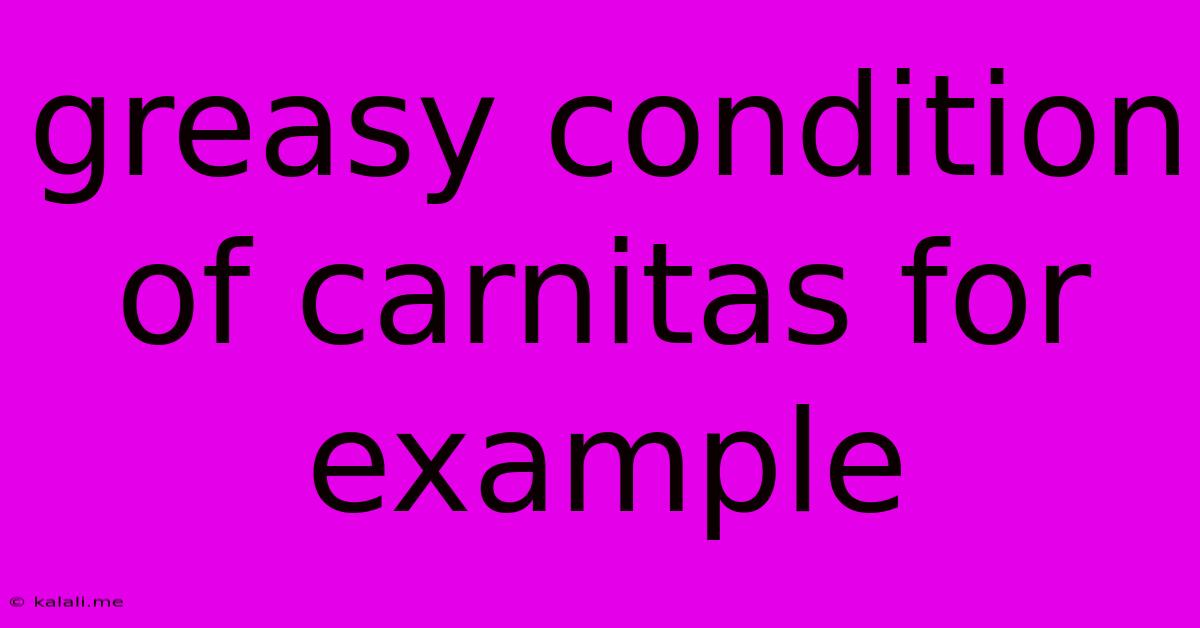Greasy Condition Of Carnitas For Example
Kalali
May 25, 2025 · 3 min read

Table of Contents
The Greasy Truth About Carnitas: Understanding and Managing Excess Fat
Carnitas, those incredibly flavorful shredded pork delights, are a culinary staple for many. But the reality is that achieving that tender, melt-in-your-mouth texture often comes with a significant amount of grease. This article delves into the reasons behind greasy carnitas, how to minimize excess fat during cooking, and tips for serving and enjoying this delicious dish without the unwanted oiliness.
Why are my Carnitas so Greasy?
The greasiness of carnitas is largely due to the cooking process. Traditional carnitas recipes involve braising or slow-cooking pork shoulder, a cut naturally rich in fat. During prolonged cooking, the fat renders out of the meat, resulting in a flavorful but often excessively greasy final product. Several factors contribute to this:
- Cut of Pork: Pork shoulder, while ideal for tender carnitas, has a high fat content. Choosing a leaner cut will reduce the overall fat, but it will also impact the final texture and flavor.
- Cooking Method: Slow cooking methods like braising or using a slow cooker allow for maximum fat rendering. While this produces tender meat, it also results in a significant amount of rendered fat.
- Lack of Fat Trimming: Failing to trim excess visible fat from the pork shoulder before cooking significantly increases the final amount of grease.
- Cooking Time: Overcooking can lead to excessive fat rendering, making the carnitas excessively greasy.
Strategies for Less Greasy Carnitas
While some fat is essential for flavor and tenderness, here are some techniques to reduce the grease content without compromising the taste:
- Trim the Fat: Before cooking, carefully trim away as much visible fat from the pork shoulder as possible. Don't be afraid to remove a generous amount.
- Choose Leaner Cuts: While not ideal for the classic carnitas texture, using a leaner cut of pork like pork loin will naturally result in less greasy carnitas. You may need to adjust cooking time and methods to achieve tenderness.
- Higher Heat Cooking: While traditional methods rely on slow cooking, experimenting with higher heat cooking methods, such as searing the pork before braising, can help render some of the fat before the slower cooking process.
- Skimming the Fat: During and after cooking, regularly skim off excess fat from the cooking liquid. This can significantly reduce the overall grease content.
- Pressing the Carnitas: After cooking, gently press the carnitas to remove excess fat. You can do this using a colander lined with paper towels or a clean kitchen towel.
- Baking instead of Braising: Baking carnitas can result in less grease compared to braising. The oven's heat helps to render fat, but the process is less likely to leave you with an excessive amount of rendered fat in the pan.
Serving and Enjoying Less Greasy Carnitas
Even with these techniques, some grease is inevitable. Here are some tips for serving and enjoying your carnitas without the excessive oiliness:
- Serve with absorbent sides: Accompany your carnitas with sides that can help absorb excess grease, such as tortillas, rice, or salad.
- Drain before serving: Before serving, drain the carnitas thoroughly in a colander to remove excess grease.
- Use a non-stick pan: If reheating, use a non-stick pan to prevent sticking and minimize the addition of extra oil.
By understanding the factors that contribute to greasy carnitas and implementing these strategies, you can enjoy this delicious dish while minimizing the unwanted fat content. Remember, the key is finding a balance between tenderness, flavor, and a manageable level of grease.
Latest Posts
Latest Posts
-
Signs Of A Blocked Fuel Filter
May 25, 2025
-
How To Flush Metal Contaminants From An Engine
May 25, 2025
-
How Long Can Tuna Salad Stay In The Fridge
May 25, 2025
-
Can You Check Into A Hotel Early
May 25, 2025
-
How Long Is Cookie Dough Good In The Fridge
May 25, 2025
Related Post
Thank you for visiting our website which covers about Greasy Condition Of Carnitas For Example . We hope the information provided has been useful to you. Feel free to contact us if you have any questions or need further assistance. See you next time and don't miss to bookmark.